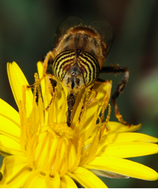How Many of Us Will Plant Native Plants and/or Join "The Map" to Add Our Small Efforts to Build Diversity and Restore Our Maryland Ecosystem?
You are encouraged to join others in Greater Farmland by adding your property to the homegrownnationalpark.org map and making any small or large changes to your gardens to encourage pollinators and promote songbirds.
Be part of the GFCA movement, and you can install a small metal sign, like the one above,
to post in your yard, indicating that it is a
Greater Farmland Pollinator Patch.
We encourage patches to include some natives in the mix and to exclude pesticides. Looking for information and ideas about enhancing your pollinator garden? Try the links below in the Resources section.
To get information or to order your sign, send an email to address below.
GFCA will pay the cost of your sign above your base $10 donation. Payment can be made under the Membership section of this site's homepage.
to post in your yard, indicating that it is a
Greater Farmland Pollinator Patch.
We encourage patches to include some natives in the mix and to exclude pesticides. Looking for information and ideas about enhancing your pollinator garden? Try the links below in the Resources section.
To get information or to order your sign, send an email to address below.
GFCA will pay the cost of your sign above your base $10 donation. Payment can be made under the Membership section of this site's homepage.
|
“... what if each American landowner converted half of his or her yard to productive native plant communities?
Even moderate success could collectively restore some semblance of ecosystem function to more than 20 million acres of what is now ecological wasteland. ” “Every square inch of planet earth has ecological significance, even where we live, work, and play. If we landscape these areas with plant function as well as aesthetics in mind, we can create viable habitat where humans are, not just where humans are not.” |
Resources to Start on Your Own Property
A wealth of information - homegrownnationalpark.org
Get a list of native plants for our locale - nwf.org/nativeplantfinder
and extension.umd.edu/resource/recommended-native-plants-maryland/
and environment@greaterfarmland.org
Tree Guide from Conservation Montgomery online.flippingbook.com/view/84733490/
and Here's a list of plants that support specific caterpillars, butterflies, and native moths
Want to identify and remove invasive plants? Here's a guide and list:
https://extension.umd.edu/resource/invasive-species/
Get a list of native plants for our locale - nwf.org/nativeplantfinder
and extension.umd.edu/resource/recommended-native-plants-maryland/
and environment@greaterfarmland.org
Tree Guide from Conservation Montgomery online.flippingbook.com/view/84733490/
and Here's a list of plants that support specific caterpillars, butterflies, and native moths
Want to identify and remove invasive plants? Here's a guide and list:
https://extension.umd.edu/resource/invasive-species/
Email environment@greaterfarmland.org.
Order a sign and tell us what you’ve done in your yard to promote birds, bees, and butterflies. It could be a very small patch or a few plants…
no plot too small!
Order a sign and tell us what you’ve done in your yard to promote birds, bees, and butterflies. It could be a very small patch or a few plants…
no plot too small!
We can each join the Park in our own yards.
- Go to the site, homegrownnationalpark.org
- View the video “What’s the Rush?” at the bottom of the homepage
- Add your property to the national map
- Plan your improvements, large or small, to encourage the native mid-Atlantic ecosystem by any of the following:
- Planting native trees, esp. oaks
- Reducing grass lawns the easy way:
- Plant a tree in the lawn and remove the grass from under the canopy
- Plant some native plants under the tree canopy
- Use the fallen leaves to “mulch” below the canopy
- This creates a new native garden bed, where local insects can fulfill their lifecycles and birds can feed and spread seeds
- The bed can grow with the tree
- Install plants native to the Mid-Atlantic
- Go to the National Wildlife Federation plant-finder for suggestions, nwf.org/nativeplantfinder
- Many local nurseries include native plant sections for easy selection
- Buy native plants at local nature center plant sales - see list on next page
- Exchange seeds, cuttings, and seedlings with neighbors
- Add a birdbath and leave ¼ of a Mosquito Dunk in it
- Install a birdhouse suitable for native birds
- Watch your yard fill with songbirds, butterflies, and native moths



